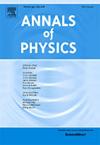Emergent universe in f(Q) gravity theories
IF 3
3区 物理与天体物理
Q2 PHYSICS, MULTIDISCIPLINARY
引用次数: 0
Abstract
One resolution of the ancient cosmic singularity, i.e., the Big Bang Singularity (BBS), is to assume an inflationary stage preceded by a long enough static state in which the universe and its physical properties would oscillate around certain equilibrium points. The early period is referred to as the Einstein Static (ES) Universe phase, which characterizes a static phase with positive spatial curvature. A stable Einstein static state can serve as a substitute for BBS, followed by an inflationary period known as the Emergent Scenario. The initial need has not been fulfilled within the context of General Relativity, prompting the investigation of modified theories of gravity. The current research aims to find such a solution within the framework of symmetric teleparallel gravity, specifically in the trendy theories. An analysis has been conducted to investigate stable solutions for both positively and negatively curved spatial FRW universes, in the presence of a perfect fluid, by utilizing various torsion-free and curvature-free affine connections. Additionally, we propose a method to facilitate an exit from a stable ES to a subsequent inflationary phase. We demonstrate that gravity theories have the ability to accurately depict the emergence of the universe.
f(Q)引力理论中的涌现宇宙
古代宇宙奇点,即大爆炸奇点(BBS)的一个解决方案是假设一个暴胀阶段,在此之前是一个足够长的静态状态,在这个静态状态中,宇宙及其物理性质将围绕某些平衡点振荡。早期阶段被称为爱因斯坦静态(ES)宇宙阶段,其特征是具有正空间曲率的静态阶段。一个稳定的爱因斯坦静态可以作为BBS的替代品,随后是一个被称为紧急情景的膨胀时期。在广义相对论的背景下,最初的需求并没有得到满足,这促使了对修正引力理论的研究。目前的研究旨在在对称遥平行引力的框架内,特别是在流行的f(Q)理论中找到这样一个解决方案。通过利用各种无扭转和无曲率的仿射连接,研究了在完美流体存在的情况下,正弯曲和负弯曲空间FRW宇宙的稳定解。此外,我们提出了一种方法来促进从稳定的ES退出到随后的通货膨胀阶段。我们证明了f(Q)引力理论有能力准确地描述宇宙的出现。
本文章由计算机程序翻译,如有差异,请以英文原文为准。
求助全文
约1分钟内获得全文
求助全文
来源期刊

Annals of Physics
物理-物理:综合
CiteScore
5.30
自引率
3.30%
发文量
211
审稿时长
47 days
期刊介绍:
Annals of Physics presents original work in all areas of basic theoretic physics research. Ideas are developed and fully explored, and thorough treatment is given to first principles and ultimate applications. Annals of Physics emphasizes clarity and intelligibility in the articles it publishes, thus making them as accessible as possible. Readers familiar with recent developments in the field are provided with sufficient detail and background to follow the arguments and understand their significance.
The Editors of the journal cover all fields of theoretical physics. Articles published in the journal are typically longer than 20 pages.
 求助内容:
求助内容: 应助结果提醒方式:
应助结果提醒方式:


